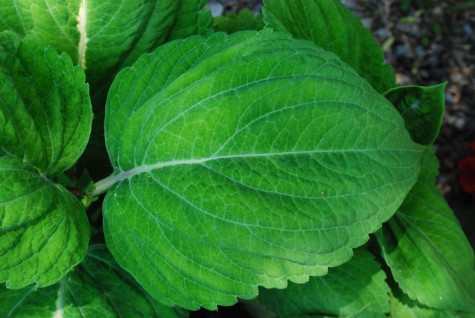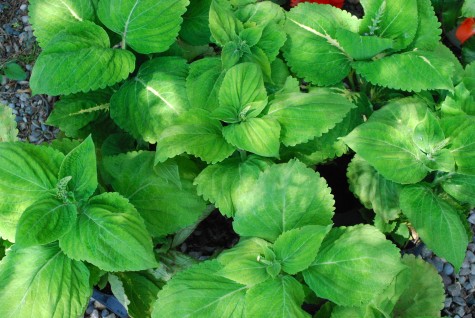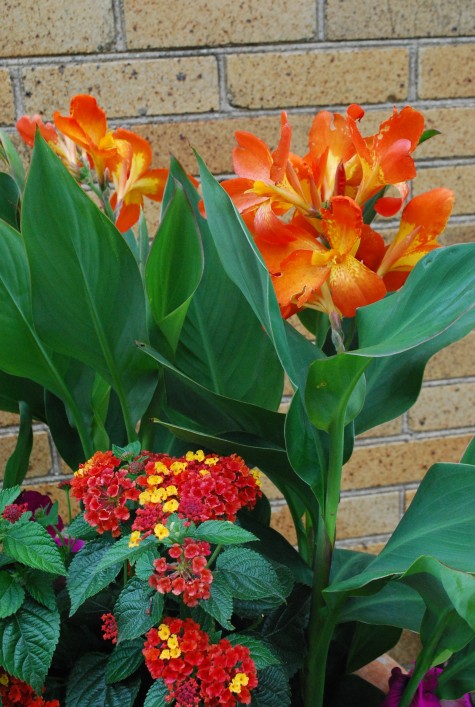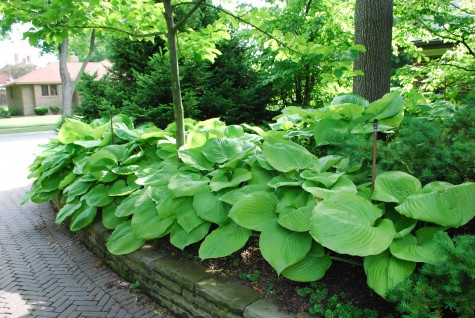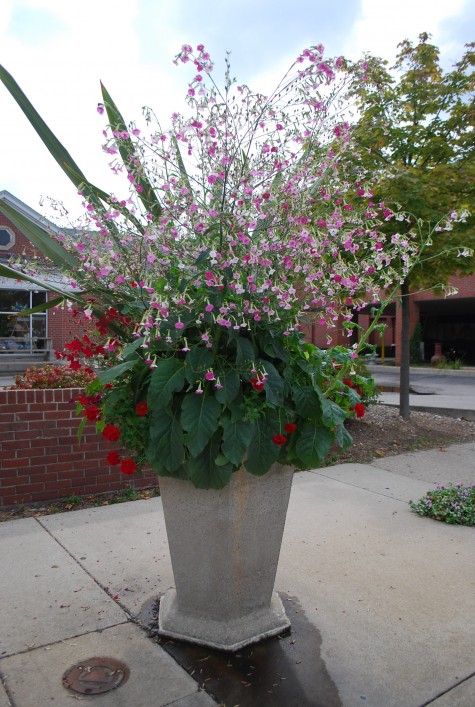I think of myself as a focused and self disciplined individual. I make a sincere effort to be organized. I am a” deal with it within twenty-four hours” girl. I try to follow a thought along, even if it is one layer under the day’s business, as long as it takes, to get that thought in a form that energizes me enough to speak, or draw. For me doing a design doesn’t stop with the drawing. A design needs explanation, supporting photographs or other material, a time frame, a plan to stage the installation. It has taken me fifteen years to install the landscape on my lot.5; why wouldn’t I address staging with everyone else?
Walking through the store in the am, on my way to my office, I can spot 15 things that need cleaning, weeding, straightening, grooming, levelling, vignetting, attention-and water. I can spot a plant that needs water when my eyes are closed. I can as well spot from yards away a plant whose green leaves have gone dusty from lack of water. I call this focused; Buck calls this obsessed. I about fainted with shock and surprise the first time he casually suggested it might be better for me all around, if I could realize that sometimes it’s good to give up. Let things go that don’t deserve your energy. Sure, be in charge, put your name to your work, think everything through, do the best you can. But most of all, give up when it’s time-good things can come of giving up. Other outcomes can be good.
I am sponsoring a tour of gardens of my design in one week, July 19, to benefit the Greening of Detroit. They have been planting trees, sponsoring urban gardens, teaching people to plant and grow to feed their families, and sell at the Eastern Market in Detroit, for the past 20 years. They impressed me. Last year we raised 10,000.00 for them; I am very proud of this. But today I am seeing that my own garden, which is on tour, is two weeks behind a normal season. There will be no Limelight hydrangeas in bloom, and my pots are not the best, given the cool weather. I see weeds, fungus, unfinished areas-and I am the person who ventured in last Sunday’s opinion post to suggest there is no World Series of Gardening. Talk is cheap, is it not??
The entire impetus for this post is a pair of fabulous Italian pots on pedestals, on my terrace, planted identically. Both pots are coming along fine, albeit slowly-except for the centerpiece plant. The nicotiana mutabilis in the north pot has spiked, and is blooming. The southern nicotiana mutabilis is in stall mode. For three days I have been agonizing over replacing that recaltricant nicotiana. Given Buck’s commentary, I think I will stand pat with the two pots that do not match. Do these two glaringly unmatched pots say everything about when it is good to give in, and give up? Do they not speak reams to what every gardener aims for, and does not get? Buck says not one gardener on the tour will fail to recognize that in spite of my efforts, our efforts, I am not really in charge. He thinks I should leave it be. I think he may be right. Better the garden be real, than engineered like a stage set.
No matter how enchanted I am with a design, my relationship with my client comes first. My ideas are just my ideas. Not the be all and end all. Great designs depend on a solid relationship between me , and my client -and whatever shakes out from there. Giving in is not necessarily a gesture of defeat. Giving in can be a recognition of the other party; a resolution not anticipated. Giving in can be a way of letting go of issues that have no resolution, for better or for worse. Giving in is sometimes a striking move; amazingly, things can be better for it. I have landscapes in which the big idea came from the client that work just fine. My two unmatched pots which will be going on tour-they are charming me.
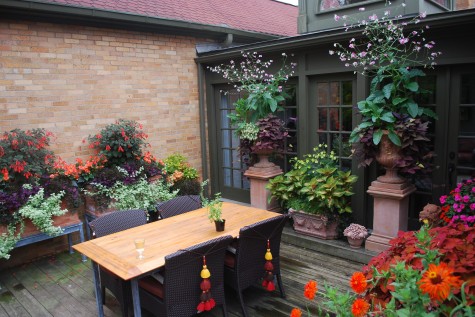
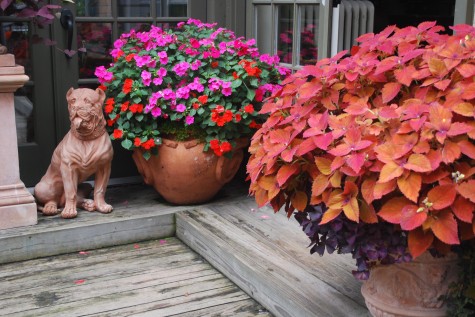 I like the fireworks going-on feeling of my terrace pots this year. Most of that has to do with how they have grown. I picked the colors and plants yes, but nature has proved unusually cooperative. We have had cool temperatures all summer, and now, regular rain. The usual bugs and disease must be at someone else’s house.
I like the fireworks going-on feeling of my terrace pots this year. Most of that has to do with how they have grown. I picked the colors and plants yes, but nature has proved unusually cooperative. We have had cool temperatures all summer, and now, regular rain. The usual bugs and disease must be at someone else’s house.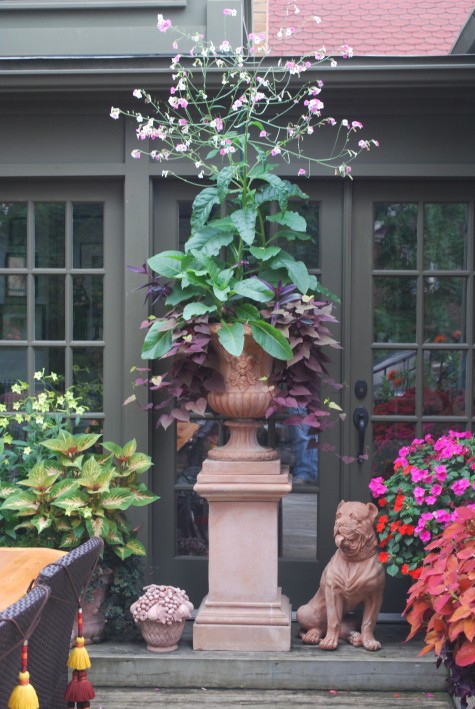 The Mital terra cotta gargoyle pots on their pedestals have never looked so rowdy and profuse. I grow nicotiana mutabilis every year for exactly the reason you see here. The showy oregano in this pot gave up and died, but I hardly notice. Besides, this pair of pots started out mismatched-I like that they will end up mismatched.
The Mital terra cotta gargoyle pots on their pedestals have never looked so rowdy and profuse. I grow nicotiana mutabilis every year for exactly the reason you see here. The showy oregano in this pot gave up and died, but I hardly notice. Besides, this pair of pots started out mismatched-I like that they will end up mismatched.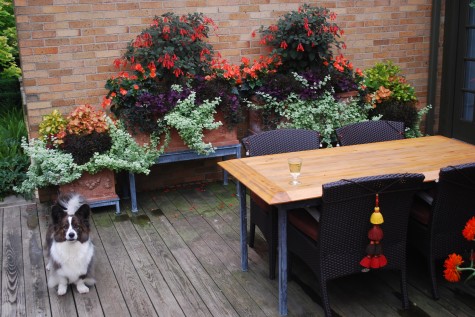
 These two licorice plants have made a flared skirt of themselves. The shape is especially attractive with the garland pattern on the pot. Did I plan this part-absolutely not. Anyone who gardens gets to enjoy the unexpected.
These two licorice plants have made a flared skirt of themselves. The shape is especially attractive with the garland pattern on the pot. Did I plan this part-absolutely not. Anyone who gardens gets to enjoy the unexpected.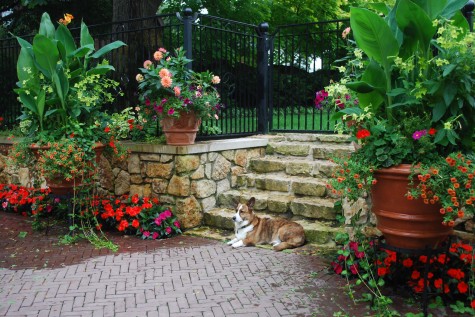 The New Guinea impatiens this year are unbelievably gaudy-what fun. Even my million bells, which usually sulk as I have very alkaline water, are cooperating. My dahlias do not have mites or mildew. The cool weather has slowed the flower production on the cannas, but the foliage alone is well worth having.
The New Guinea impatiens this year are unbelievably gaudy-what fun. Even my million bells, which usually sulk as I have very alkaline water, are cooperating. My dahlias do not have mites or mildew. The cool weather has slowed the flower production on the cannas, but the foliage alone is well worth having.
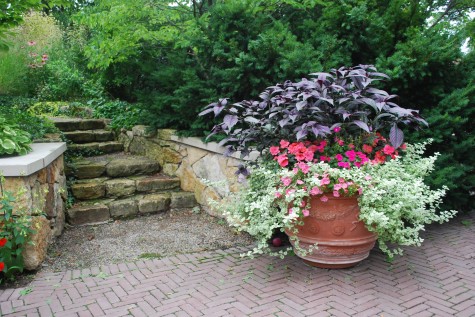
 Given that I took this picture September 24, why wouldn’t I be unprepared for the weather here this past week? Just three weeks ago, I still had my summer. Though describing any Michigan weather as “ordinary” is glossing over the truth, our weather ordinarily cools off at a slow enough pace to make keeping up with the job of putting the garden to sleep relatively easy. My fall cleanup and shovelling out is based on the distinction I draw between gardening, and housekeeping.
Given that I took this picture September 24, why wouldn’t I be unprepared for the weather here this past week? Just three weeks ago, I still had my summer. Though describing any Michigan weather as “ordinary” is glossing over the truth, our weather ordinarily cools off at a slow enough pace to make keeping up with the job of putting the garden to sleep relatively easy. My fall cleanup and shovelling out is based on the distinction I draw between gardening, and housekeeping.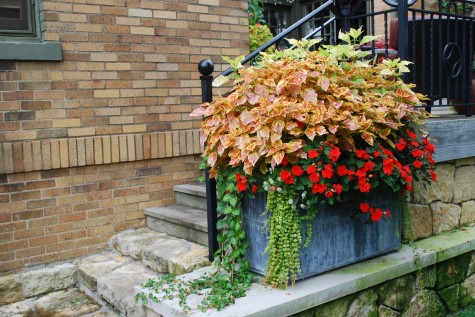 I have seen those properties that look as though every shred of organic debris has been blown, vacuumed up and disposed of weekly; anyone who has inadvertently turned a blower on themselves realize what an invasion they are. Every green leaf looks dusted; every surface has been swept, every shred or organic debris is bagged and removed. The stone is scrubbed clean, and the cushions are only on the furniture when company is in attendance. I like the look of cultivated soil as well as the next person, but all of the above is housekeeping, not gardening. Years ago a gardener whom I greatly respect, Marge Alpern, told me she disturbed her plants as little as possible. She maintained that plants can be worried such that they refuse to prosper. I think this is a point well taken. I will not take on the perennial gardens until much later in the fall.
I have seen those properties that look as though every shred of organic debris has been blown, vacuumed up and disposed of weekly; anyone who has inadvertently turned a blower on themselves realize what an invasion they are. Every green leaf looks dusted; every surface has been swept, every shred or organic debris is bagged and removed. The stone is scrubbed clean, and the cushions are only on the furniture when company is in attendance. I like the look of cultivated soil as well as the next person, but all of the above is housekeeping, not gardening. Years ago a gardener whom I greatly respect, Marge Alpern, told me she disturbed her plants as little as possible. She maintained that plants can be worried such that they refuse to prosper. I think this is a point well taken. I will not take on the perennial gardens until much later in the fall. A series of nights with temperatures hovering in the mid thirties left my pots looking like this-devastated. It does not matter one bit that I know this day is coming, I am never ready for it, nor do I like it. I do not like to let go. On a much more dramatic scale than the time changing to daylight savings, I adjust slowly, and poorly.
A series of nights with temperatures hovering in the mid thirties left my pots looking like this-devastated. It does not matter one bit that I know this day is coming, I am never ready for it, nor do I like it. I do not like to let go. On a much more dramatic scale than the time changing to daylight savings, I adjust slowly, and poorly.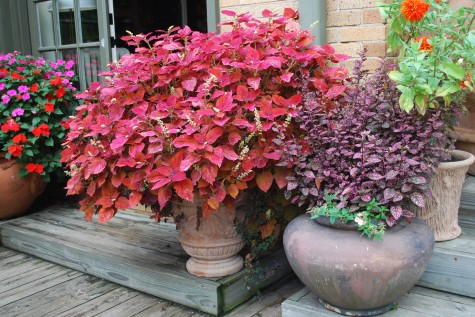 Coleus are astonishingly intolerant of cold weather. Anyone who does poorly with them is probably planting them out too early; every plant thrives in some conditions, and sulks in all else. This five foot diameter fiery orange ball was glorious all season; in late August the corgis were breaking off the branches encroaching on the doorway. They keep the extreme understory clear of any obstructions.
Coleus are astonishingly intolerant of cold weather. Anyone who does poorly with them is probably planting them out too early; every plant thrives in some conditions, and sulks in all else. This five foot diameter fiery orange ball was glorious all season; in late August the corgis were breaking off the branches encroaching on the doorway. They keep the extreme understory clear of any obstructions.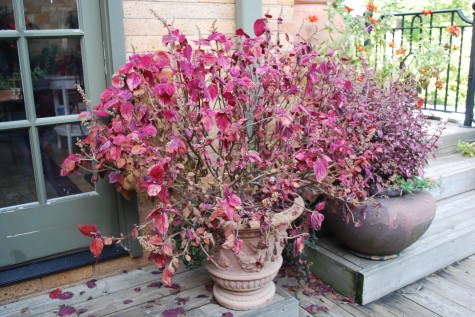 In what seemed like the blink of an eye my fireball shed almost every leaf. Unlike the gingko tree which sheds every leaf on that certain perfect fall day, leaving a beautiful pool of yellow on the ground, the coleus leaves dessicate, drop, and disappear before you can even mourn properly.
In what seemed like the blink of an eye my fireball shed almost every leaf. Unlike the gingko tree which sheds every leaf on that certain perfect fall day, leaving a beautiful pool of yellow on the ground, the coleus leaves dessicate, drop, and disappear before you can even mourn properly. 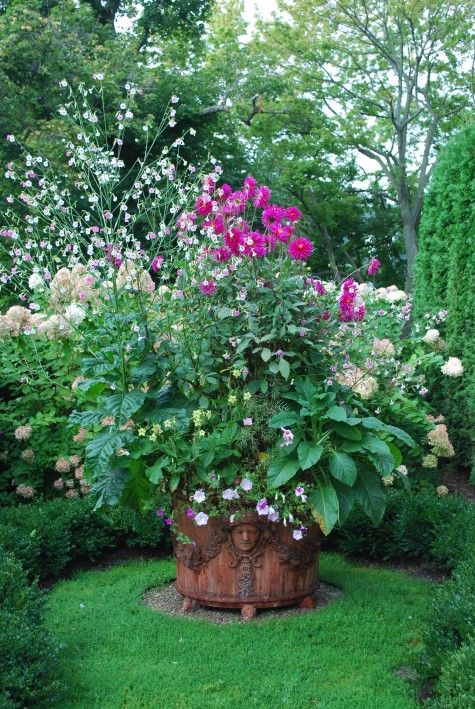 My English-made Italian style pots were home to the biggest bouquet I have ever grown. The nicotiana mutabilis got busy throwing spikes in September, and the dahlias were blooming profusely. I like that extravagant and exuberant look. No matter how the day had gone, I could go home and congratulate myself on having grown one of the annual wonders of the western world. You may be laughing, but how the look of it pleased and cheered me.
My English-made Italian style pots were home to the biggest bouquet I have ever grown. The nicotiana mutabilis got busy throwing spikes in September, and the dahlias were blooming profusely. I like that extravagant and exuberant look. No matter how the day had gone, I could go home and congratulate myself on having grown one of the annual wonders of the western world. You may be laughing, but how the look of it pleased and cheered me. 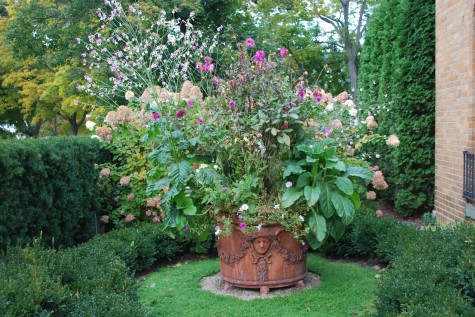 Though the nicotiana mutabilis is yet bravely defending its home, the cold pierced the heart of the whole. Buck is always amazed and amused and the depth and breadth of the despair which attends the beginning of the end of my gardening year. I alternately rage and whine-he murmurs, and pours the wine.
Though the nicotiana mutabilis is yet bravely defending its home, the cold pierced the heart of the whole. Buck is always amazed and amused and the depth and breadth of the despair which attends the beginning of the end of my gardening year. I alternately rage and whine-he murmurs, and pours the wine.  This sister to my pots, adapted for use as a fountain, bears all the signs of a season’s worth of mineral laden water, weather,heat and growth. Does that gorgeous Italianate face not seem completely grief stricken?
This sister to my pots, adapted for use as a fountain, bears all the signs of a season’s worth of mineral laden water, weather,heat and growth. Does that gorgeous Italianate face not seem completely grief stricken? 
